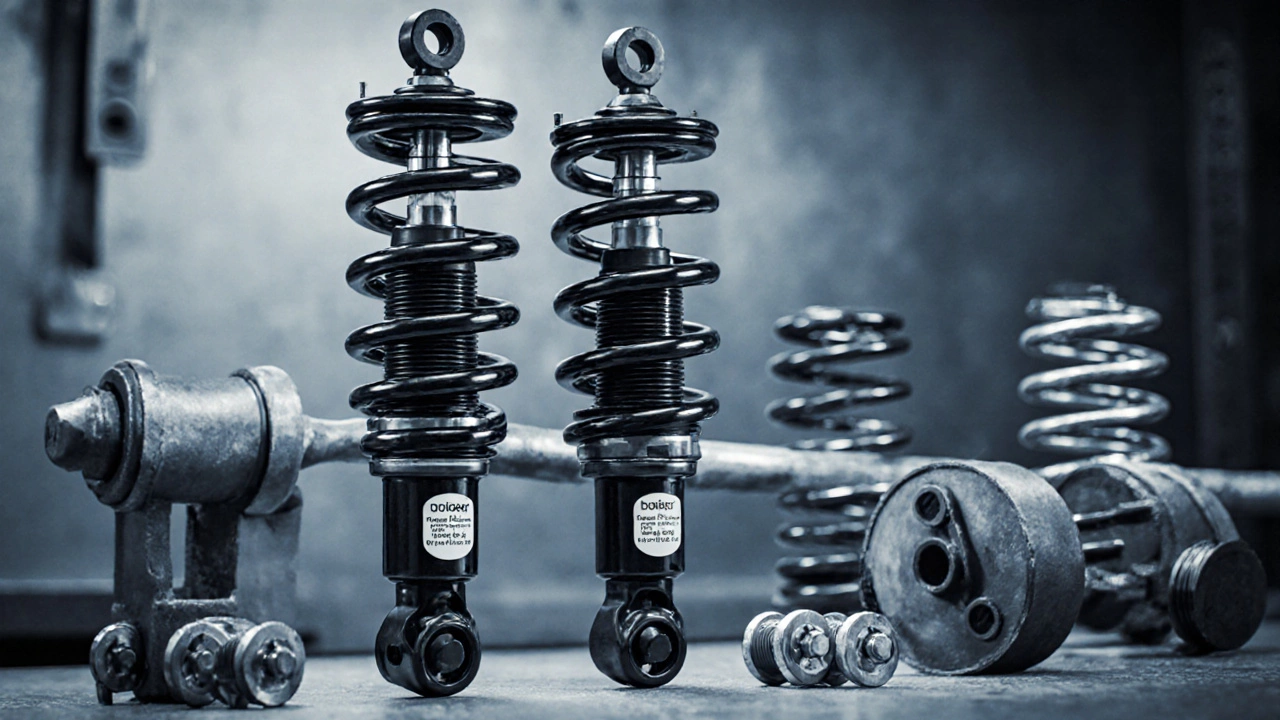Suspension Setup Selector
Recommended Suspension Setup
Setup Characteristics
Recommendations
Key Takeaways
- Soft suspension delivers a comfy ride but can feel sluggish in aggressive driving.
- Stiff suspension improves handling and road feedback, yet may cause a harsher experience on rough surfaces.
- Match the setup to your primary driving conditions - city commuting, highway cruising, or track days.
- Adjustable components like shock absorbers and anti‑roll bars let you fine‑tune the balance.
- A well‑chosen suspension reduces tire wear and protects other components.
When you’re torn between a plush ride and razor‑sharp cornering, the question soft vs stiff suspension pops up. The answer isn’t a simple yes or no - it hinges on how you use your car, the roads you travel, and what you value most behind the wheel. This guide breaks down the mechanics, the trade‑offs, and the practical steps you can take to pick the right feel for your daily drive or weekend track session.
Vehicle suspension is the system of springs, shock absorbers, linkages, and other components that connects a car’s chassis to its wheels, controlling how it moves over road irregularities. Its main jobs are to keep the tires in contact with the road, absorb bumps, and manage body roll during cornering. Two extreme philosophies dominate the market: soft setups that prioritize comfort, and stiff setups that chase performance.
Understanding Soft Suspension
Soft suspension uses lower‑rate springs and more compliant shock absorbers to allow greater wheel travel and absorb road imperfections. The result is a smoother ride, especially on uneven city streets or pothole‑laden routes. Soft springs keep the chassis from bouncing excessively, while the shock absorbers dampen motion gently, creating a floating sensation that many daily drivers love.
Key attributes of a soft setup:
- Lower spring rate - measured in kg/mm or lb/in, indicating how much force is needed to compress the spring.
- Longer shock absorber stroke, often paired with “soft” damping settings.
- Higher body roll during cornering, which can feel less precise.
- Reduced stress on tires and other chassis components because impacts are spread out.
Understanding Stiff Suspension
Stiff suspension features higher‑rate springs and firmer shock absorber settings to limit wheel movement and improve handling response. It’s the go‑to for sport‑oriented cars, track enthusiasts, and drivers who crave direct feedback from the road. The chassis stays flatter through turns, and the tires maintain a more consistent contact patch, boosting grip.
Typical traits of a stiff setup:
- Higher spring rate, making the springs resist compression.
- Shorter shock absorber travel with “hard” damping curves.
- Reduced body roll, giving a planted feel in corners.
- Potentially harsher ride over potholes, which can increase tire wear if not managed properly.

How Spring Rate and Damping Shape Your Experience
The two core variables that define softness or stiffness are spring rate the amount of force required to compress a spring by a given distance and damping the resistance provided by shock absorbers to control spring oscillations. A low spring rate paired with soft damping yields a plush ride; a high spring rate with firm damping creates a performance‑focused feel.
Adjusting either factor changes the balance. For example, swapping to a slightly softer shock on a stiff spring can tame harshness without sacrificing handling, while upgrading to a stiffer spring on a soft car can improve cornering at the cost of some comfort.
Side‑by‑Side Comparison
| Aspect | Soft Suspension | Stiff Suspension |
|---|---|---|
| Ride Comfort | High - absorbs bumps well | Low - transmits more road harshness |
| Handling Precision | Moderate - more body roll | High - reduced roll, sharper response |
| Tire Wear | Generally lower due to smooth impacts | Potentially higher if harshness causes wheel hop |
| Ideal Vehicles | Daily drivers, luxury sedans, off‑road SUVs | Sports cars, track cars, performance hatchbacks |
| Typical Use Cases | City traffic, long highway cruises, comfort‑focused owners | Track days, spirited canyon runs, drivers who demand feedback |
| Cost of Upgrades | Usually lower - softer springs are cheaper | Higher - stiffer springs and performance shocks cost more |
Choosing the Right Setup for Your Needs
Start by profiling your typical driving environment:
- City commuter - frequent potholes, stop‑and‑go traffic, occasional highway bursts. Soft suspension wins on comfort and reduces fatigue.
- Highway cruiser - long, straight stretches with occasional curves. A moderately soft to medium setup offers a balance.
- Track enthusiast - high‑speed cornering, quick direction changes, and zero tolerance for body roll. Stiff suspension provides the needed grip and predictability.
- Performance daily driver - enjoys spirited driving on back roads but also needs comfort for errands. Consider a tunable system like coilovers that let you dial in a medium stiffness and adjust damping on the fly.
Other factors to weigh:
- Vehicle weight - heavier cars benefit from slightly softer springs to avoid a harsh ride, while lightweight sports cars can handle firmer springs.
- Wheel and tire size - larger, low‑profile tires transmit more road feel, meaning a softer suspension may become too squishy.
- Budget - quality adjustable components cost more but give the flexibility to evolve your setup as driving habits change.
Practical Tuning Tips
Even if you stick with the factory setup, a few tweaks can improve your experience:
- Upgrade shock absorbers: Replace stock shocks with units that offer multiple damping settings. This lets you soften the ride without changing springs.
- Adjust anti‑roll bars (anti‑roll bar a torsion bar that reduces body roll by linking the left and right suspension sides). Thinner bars increase softness; thicker bars tighten roll.
- Consider coilovers (coilover an integrated spring and shock assembly that allows ride height and damping adjustments). These give the most freedom - you can start with a medium spring rate and fine‑tune from there.
- Check alignment: Improper camber or toe can make any suspension feel unpredictable. A proper alignment ensures the tires stay square to the road, preserving both comfort and grip.
- Regularly inspect bushings: Worn rubber bushings amplify harshness in a stiff setup and cause excess play in a soft one. Replace them before they affect handling.

Common Mistakes to Avoid
- Going all‑in on stiffness for a daily driver - the extra harshness leads to driver fatigue and may damage tires.
- Choosing ultra‑soft springs on a performance car - the car will feel floaty, lose grip, and suffer from excessive body roll.
- Neglecting tire pressure - too low or too high pressure can mask or exaggerate suspension traits.
- Skipping regular maintenance - worn shocks or broken springs degrade both comfort and safety, regardless of stiffness.
Maintenance, Longevity, and Tire Wear
Tire wear the rate at which a tire’s tread is consumed, influenced by alignment, suspension, and road conditions is a good health indicator. A too‑stiff setup can cause rapid wear on the outer edges of the front tires during cornering, while a very soft system can lead to uneven wear if the tires constantly bounce.
To keep both suspension and tires in shape:
- Rotate tires every 5,000-7,500 miles.
- Inspect shock absorbers for leakage or reduced damping.
- Replace worn springs or bushings promptly.
- Maintain recommended tire pressure (usually listed on the driver’s door jamb).
Bottom Line - No One‑Size‑Fits‑All Answer
The decision between soft and stiff suspension boils down to three questions:
- What’s my primary driving scenario - comfort‑focused commuting or performance‑focused cornering?
- How much road imperfection am I willing to accept?
- Am I ready to invest in adjustable components to fine‑tune the balance?
Answer those honestly, and you’ll land on the setup that feels right for you. Remember, many owners start with a soft baseline and gradually stiffen elements as confidence and needs evolve. The flexibility of modern coilovers and adjustable shocks means you don’t have to pick a permanent side; you can enjoy a comfortable daily ride and still dial in a tighter feel for the occasional track day.
Frequently Asked Questions
Will a stiffer suspension damage my car’s interior?
A very stiff setup can transmit more vibration to the cabin, making the ride feel harsher. Over time, this may lead to faster wear of interior trim or cause fatigue for occupants, especially on rough roads. Mitigate this by using quality bushings and selecting a damping curve that softens low‑speed bumps while staying firm during aggressive maneuvers.
Can I install softer springs on a sports car without losing performance?
Yes, if you pair softer springs with adjustable dampers that can stay firm when needed. This approach, often called a "comfort‑performance" setup, gives a more compliant ride for daily use while still allowing you to tighten the shocks for track sessions. However, expect a slight increase in body roll compared to a full‑stiff configuration.
How does vehicle weight affect the choice between soft and stiff suspension?
Heavier cars benefit from slightly softer springs to avoid a jarring ride, as the additional mass already provides natural damping. Light‑weight sports cars, meanwhile, often need stiffer springs to prevent excessive bounce and to keep the chassis planted during fast direction changes.
Do adjustable coilovers replace the need for anti‑roll bars?
Coilovers give you control over spring rate and damping, but they don’t directly manage body roll. Anti‑roll bars work alongside coilovers to limit roll. For a balanced setup, you’ll often adjust both - select the appropriate spring stiffness in the coilovers and then fine‑tune the anti‑roll bar thickness to achieve the desired roll characteristics.
Is there a risk of breaking the suspension if I go too soft?
Going extremely soft can lead to bottoming out, where the spring or shock reaches its limit and transfers harsh impact straight to the chassis. This can damage mounts, control arms, or even the chassis over time. Stick to spring rates recommended for your vehicle’s weight and purpose, and consider progressive springs that become firmer as they compress.






